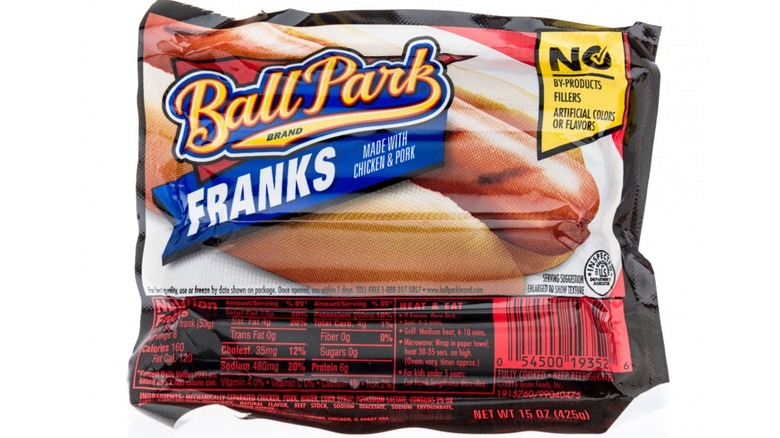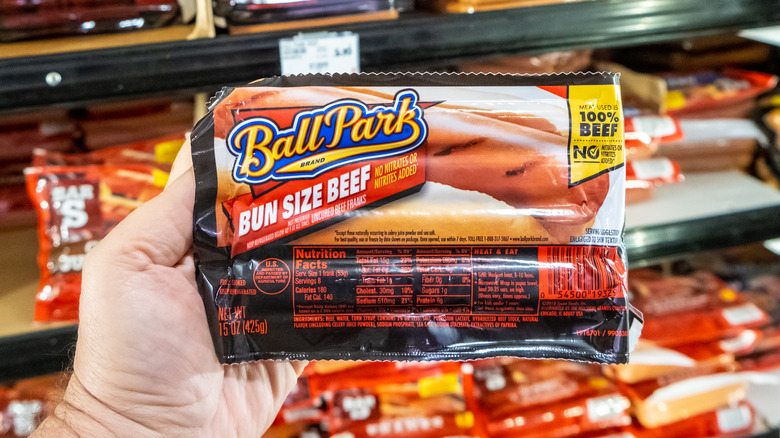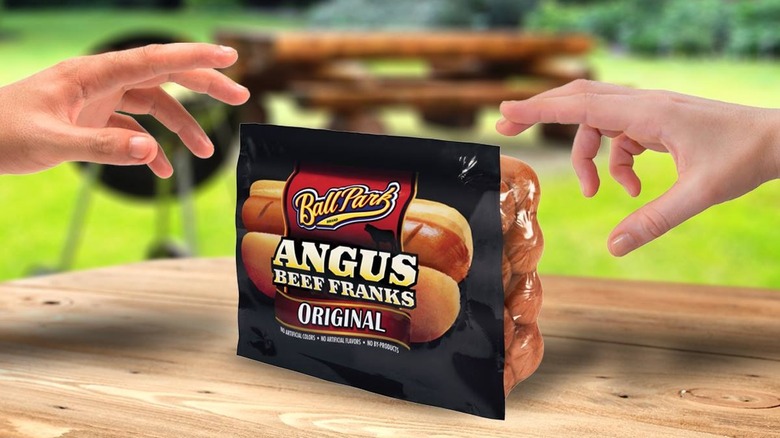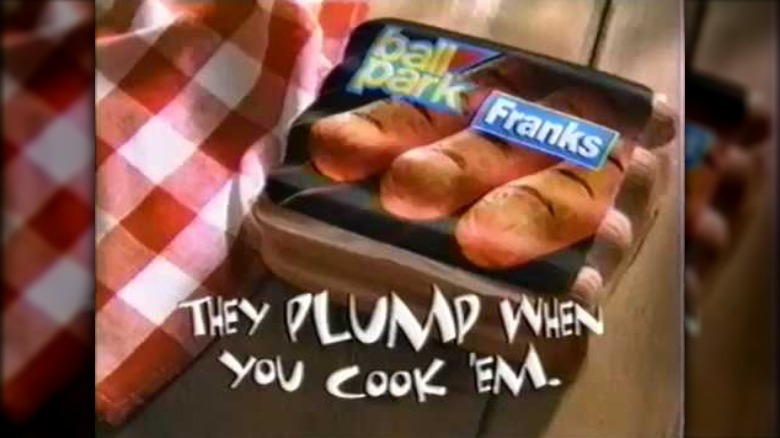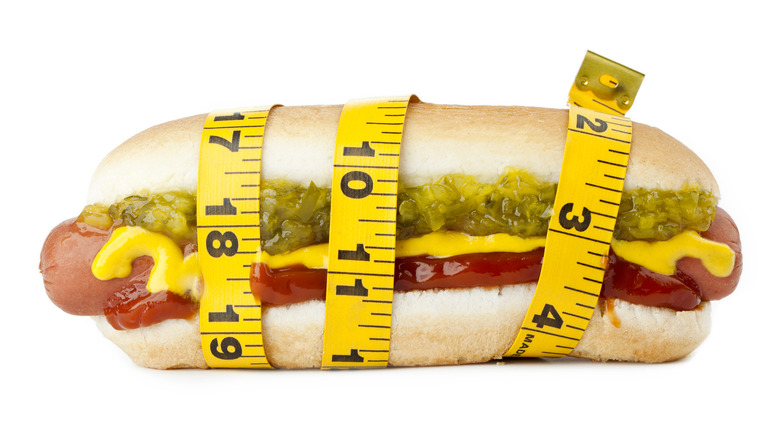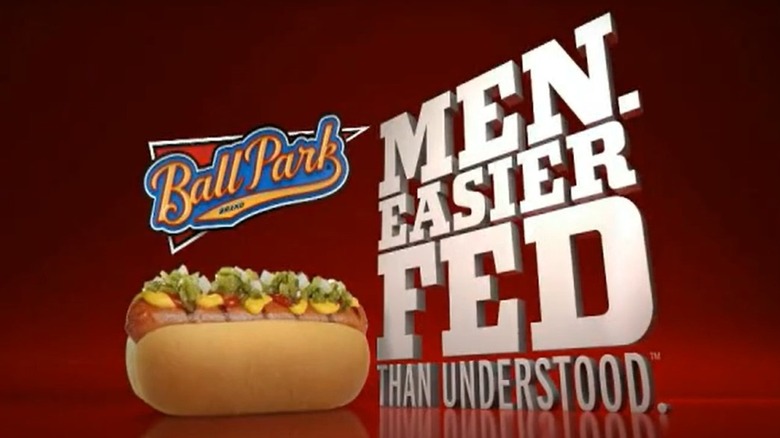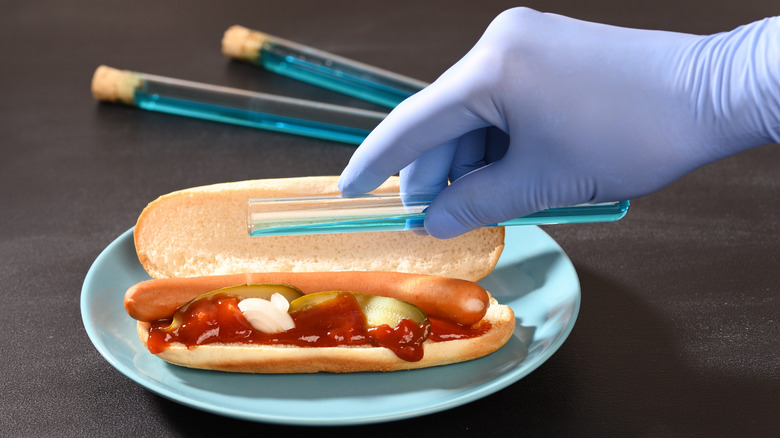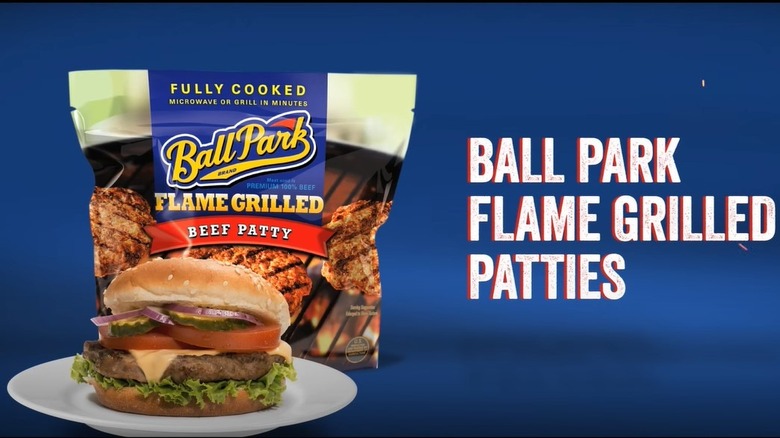The Untold Truth Of Ball Park Franks
Hot dogs are as American as it gets. While their predecessor, the frankfurter, can trace its origins back to Frankfurt, Germany, in the 15th century, according to The National Hot Dog and Sausage Council, the decision to serve and eat the sausage on a bun was first done in New York in the 1860s. Since then, hot dogs have become synonymous with the summertime, baseball games, and backyard cookouts in the U.S.
But not all hot dogs are created equal. And if there's one brand that stands tall above the competition, from both a taste and popularity standpoint, it's Ball Park Franks. It may not sponsor the annual Hot Dog Eating Contest every Fourth of July on Coney Island — that distinction belongs to Nathan's Famous Hot Dogs — but there's little doubt the "plump when you cook 'em" wieners hold a special place in hearts throughout the nation.
There's arguably no better time to enjoy a Ball Park Frank than the summer, and no more appropriate season (it is the height of baseball season, after all) to reflect on this thoroughly American item. Since the untold truth of Ball Park Franks is sure to raise an eyebrow or two, let's take a look at some of the more interesting tidbits surrounding this product, and the unique journey it's taken from local favorite to national hero.
Ball Park Franks were originally created for the Detroit Tigers
Were you under the impression the "ball park" moniker is just some sort of marketing gimmick, designed to capture the hearts and stomachs of baseball lovers around the nation? Well, you're (sort of) mistaken. The hugely popular brand's name was actually derived from the fact that it was originally created specifically for the Detroit Tigers and sold at Tiger Stadium starting in 1957.
Upon discovering the Tigers were searching for a new game day hot dog provider to help boost sales at the ballpark, Michigan-based meat purveyor, Hygrade Food Products, decided to spring into action. Believing it could create a product that fans would flip their lids over, the company developed what would eventually be known as the Ball Park Frank for the organization (via Detroit Free Press). It didn't take long for fans to fall in love with Ball Park Franks, and by 1959 they were available in grocery stores in Detroit. Less than ten years later, they'd become a sensation in ballparks and beyond across the country.
It's the most popular hot dog brand in the U.S.
Many brands like to proclaim themselves number one, whether or not the facts back them up. Luckily for Ball Park, it can rest easy knowing it was the most popular hot dog brand in the U.S., and by a fairly wide margin — and it's got the numbers to prove it (via Statista). Ball Park Franks have become an American icon since they were first sold more than a half-century ago, with annual sales topping half a billion dollars (via Detroit Free Press).
It's understandable why, of course: Ball Park Franks are undeniably delicious in a dependable, delightful way. It's an irresistible sandwich, whether it's grilled, boiled, or fried — and yes, it is a sandwich, at least according to famous chef and "Chopped" judge, Alex Guarnaschelli. Whether you consider yourself a mustard purist, swear by ketchup on your hot dog, or love to mix it up with both, you're in good company if you're reaching for Ball Park Franks.
Ball Park favors prestige over profits
You would think the original developers of Ball Park Franks were surely hoping to make a fortune with their creation. But for the humble meat manufacturer, the motive wasn't about money. As former Hygrade Food Products president, Clyde Riley, wrote in his book, "Speaking Frankly," the original opportunity wasn't expected "to be a big moneymaker" — it was a chance for the company to "gain much prestige."
While the tube-shaped protein was already a ubiquitous presence in the U.S. at the time, "hot dogs were a problematic business for meatpackers" during the 1950s, according to Riley. Bogged down by "price wars" between competing grocery stores, hot dogs were sold as a loss leader — an item a store intentionally sells at a loss to entice shoppers into purchasing additional, more profitable items. Luckily, the indisputable popularity of Ball Park Franks among Tiger Stadium attendees provided a justification for grocery stores to carry a premium (and therefore more expensive) hot dog. The stores were happy, the customers were delighted, and it didn't take long before Hygrade had a dearly beloved brand under its belt.
Sausage maker Gus Hauff invented the original recipe
We know Hygrade Food Products was responsible for the creation of Ball Park Franks. But who, exactly, deserves the lion's share of the credit for the existence of this toothsome, popular stadium food? That would be Hygrade's "wurstmacher," or sausage maker at the time, Gus Hauff (via "Speaking Frankly" by Clyde Riley). Without his unbeatable recipe, Ball Park Franks would've never existed beyond a figment of the imagination. And, as noted in "Speaking Frankly," without a chance shared taxi ride with Hygrade founder, Sam Slotkin, Hauff may have never even worked for the company in the first place.
There's not much information available regarding Hauff and his professional or personal history, though there's little doubt he was a master of his craft. He tinkered with his secret recipe, adding different meat than what was typically found in hot dogs, not to mention more substance overall — Ball Park Franks are known for being plump, after all — until he created a snack fans couldn't resist (via Detroit Free Press).
The original Ball Park Franks were made with veal
The cultural tastes that dictate which foods are popular have ebbed and flowed throughout human existence. Not only that, but as society has evolved, certain foods have fallen out of favor — like certain animal products that are processed or raised in a cruel and inhumane manner. Perhaps no product better exemplifies the trend than veal. But while it is largely frowned upon in 2022, veal was actually a key component in the original Ball Park Frank recipe (via Detroit Free Press).
It's hard to even fathom a company excitedly adding veal to any food product today. After all, veal crates have been banned in 14 states as of 2022 (via ASPCA), and few would be willing to call themselves veal aficionados in the 21st century. But in the late 1950s, when Hygrade sausage maker, Gus Hauff, needed to slightly rework the hot dog served at Tiger Stadium for mass production and sales, he chose veal as the meat to incorporate. While it's not clear when the recipe changed, you can rest assured that today, Ball Park Franks are made with 100% beef.
The famous slogan was conceived on a whim
Sometimes, the best ideas in life aren't those developed through intense scrutiny or brainstorming sessions. On occasion, the most inspired moments happen off the cuff, when your brain produces something brilliant without even knowing how you came to it. This seems to be the case with Ball Park Franks' famous slogan, "they plump when you cook 'em," which was conceived almost by accident.
As Ball Park Franks became more popular during the 1960s, Hygrade executives were looking to strike while the iron was hot, and further increase the appeal of Ball Park Franks through catchy marketing. One day, a hired advertising executive pressed the company's sausage maker, and original developer of the Ball Park Frank, Gus Hauff, on what made the hot dog special. He exclaimed on a whim, "because they plump when you cook them" (via Detroit Free Press). Recognizing the potential in this explanation, the company ran wild with their new slogan, helping boost the popularity and visibility of Ball Park Franks for decades to come.
Ball Park Franks are slightly larger than average hot dogs
Perhaps part of the reason Ball Park Franks took off so quickly is that they are so filling — a great trait for any snack food meant to satisfy hungry sports fans who want to keep their eyes on the game. And that's no accident, either. The hot dogs were actually designed by Hygrade Food Products to be a bit larger than other hot dogs available in the 1950s (via Detroit Free Press).
Back then, hot dogs were sold in packages containing 10 frankfurters per pound on average. Most meat purveyors focused on packing more products into packages at that time, using the cheapest possible ingredients to reduce the risk of lost profits. However, hoping to capture customers' affection with a "meatier" product, as noted in the book, "Speaking Frankly," Hygrade chose to only produce eight hot dogs per pound. While that meant consumers got less servings in a package, clearly they considered getting more bang in each bite as getting more bang for their buck as well.
Ball Park Franks have been marketed as manly food
The decision by companies to portray a product as either overly masculine or feminine may be as old as the entire concept of marketing. Gender-specific ad campaigns are a natural byproduct of our culture's intense desire to organize people into comprehensible categories. Ball Park Franks is no stranger to this concept. In 2001 the company chose to shift away from its iconic "plump when you cook 'em" slogan and adopt another catchphrase with a more niche appeal: "Eat like a Man" (via Chicago Tribune).
After hiring advertising agency Leo Burnett to develop a new marketing strategy, Ball Park embraced the fact it sold "big hearty hot dogs," as one Leo Burnett employee said to the Chicago Tribune, because "a lot of men eat hot dogs." While hot dogs may be beloved by Americans of all creeds, and genders, clearly Ball Park felt it could garner more appeal by positioning itself as a guy's food — one that was easy to make, easy to eat (especially while catching a game), and no fuss to clean up. The strategy must have proven somewhat successful, since the company continued to focus on its product's manly status more than a decade later, launching the slogan, "Men. Easier Fed than Understood" in 2012 (via Progressive Grocer).
The brand eliminated nitrates and nitrites in 2017
The ability to preserve and sustain virtually any and all food items well past their natural expiration date is a marvel of modern culinary capabilities. But in recent years, a backlash has swelled against a number of preservation techniques and ingredients used in our food as the long-term, often negative, health impacts of certain food additives has come into focus. And perhaps no food chemicals or compounds have become more controversial than nitrites and nitrates, which led Ball Park Franks to remove both from its products in 2017 (via Tyson Foods).
Nitrites and nitrates are both naturally-occurring compounds found in a number of plant-based foods, and are also often used to preserve processed foods (via Healthline). But according to research published in the academic journal, Antioxidants, both compounds can possibly become carcinogenic once metabolized by the body. — adding to public concern about using them so prominently to preserve foods, like hot dogs.
Understanding the average consumer's preference to avoid harmful food preservatives whenever possible, Ball Park opted to eliminate both chemicals entirely from its franks. As brand director, Colleen Hall, told The National Provisioner in 2017, the company hoped to offer "transparency" to consumers regarding its products, and ensure customers could "feel even better when choosing Ball Park" foods in the future.
Ball Park began selling frozen burgers in 2012
When you hear the name Ball Park Franks, the first thing that comes to anyone's mind isn't going to be hamburgers. But with a stronghold on one half of the backyard cookout standards, the Ball Park brand decided to try its hand on the other half of the grilling holy duo, introducing frozen hamburger patties in 2012 (via Chicago Tribune).
It's entirely possible Ball Park's foray into burgers could have fallen flat. But the brand was likely betting that customers would trust its handle on all things beef. It helps that the burgers are just about as easy to prepare as their hot dog brethren. The fully cooked patties can be ready in minutes, and can be heated in the microwave, in a skillet, or on the grill. Ball Park's burgers are still sold in grocery stores a decade after being introduced, as indicated on the company's website. And customers can even shake things up with flavor varieties, including a beef patty with onion, and one with cheese and bacon.
Michael Jordan endorsed Ball Park Franks
If you didn't live through the 1990s (or you're not a big basketball fan), it may be tough to envision the way Michael Jordan dominated the decade's cultural landscape. Frankly, the man was everywhere during the apex of his playing career in the '90s; he won a record six NBA titles in eight years, saved the Looney Tunes in "Space Jam," and acted as a spokesman for a number of companies and products — including Ball Park Franks. He became the face of several Ball Park print ads (touting "the hot dogs hot dogs love") as well as a handful of TV commercials via BallisLife.com).
It seems fair to wonder just how often an elite athlete — especially one who was, arguably, one of the greatest in the history of sports — actually eats hot dogs. But whether or not Jordan was indulging in Ball Park Franks on a regular basis didn't seem to matter to the company, the public, or the players himself. It stands to reason that it wasn't a simple passion for the products that prompted Jordan to become the main pitch person for more than 10 brands during the 1990s. It's worth noting that he earned between two and five million dollars per year for each brand he endorsed (via The Baltimore Sun).
There have been rumors of razors in packages
While none of us may ever know (or want to know) exactly what goes into making a hot dog, the public seems confident enough that there's nothing too dangerous in those processed meat sticks. However, at one point in time, that wasn't the case, thanks to some seriously outrageous rumors. In the early 1980s, word started to spread that people were finding sharp objects in their Ball Park Franks. Specifically, several people claimed there were razor blades in the packages they purchased.
In response to the accusations, the company made the swift decision to remove the product from stores in five states — a move that cost Ball Park Franks roughly a million dollars in sales, according to UPI. Thankfully, for both consumers and the company, several accusers eventually admitted to lying, and the stories about sharp objects in the popular hot dogs were revealed to be nothing more than hoaxes.
Rumors of razor blades being found in Ball Park Frank packages popped up once again in 1989. Horrifyingly enough, this time it was true — but not because of gross negligence on behalf of the company. A New Jersey man was arrested and charged after he admitted to placing broken razor blades into several Ball Park Frank packages at his local grocery store (via Deseret News).
